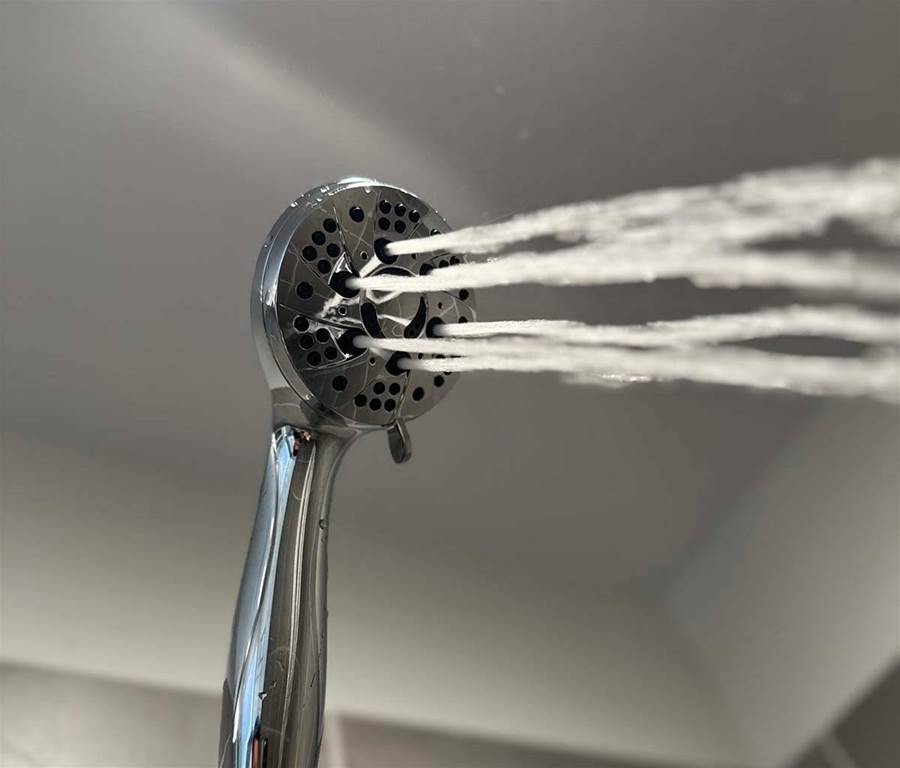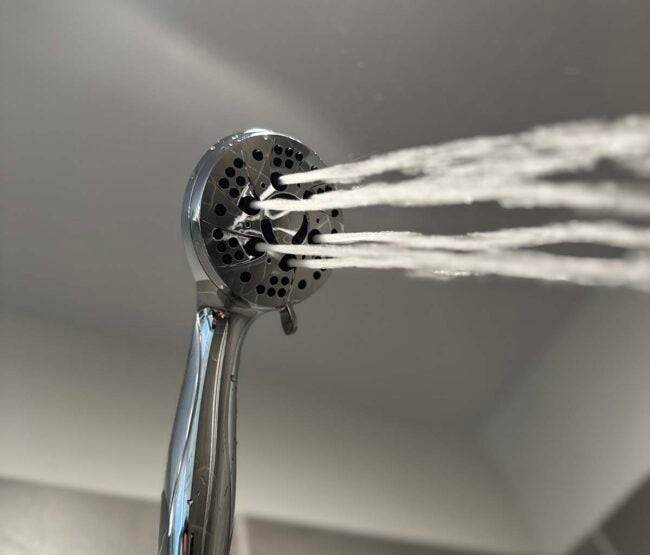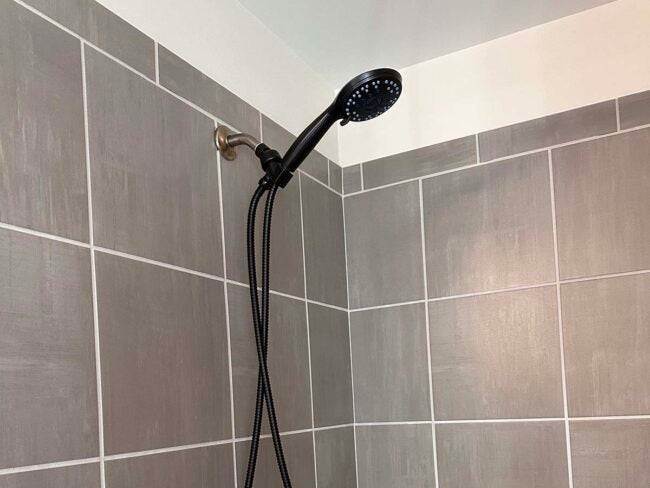

Whether you’re exploring shower heads for a bathroom renovation, looking for more water pressure, or simply want an aesthetic upgrade, there are numerous options available. From luxurious rain shower heads to basic handheld models, these fixtures come in many forms and finishes to complement any bathroom space. With spray settings like refreshing mist, massaging high pressure, or water saving, this seemingly simple purchase can make your bathing experience more enjoyable and less costly.
In an effort to find the best shower head, we tested 10 models, evaluating their coverage, water pressure, and spray patterns to find the ones that performed best.
Of those 10, two didn’t make the cut, and we can’t recommend them.
Read on for tips on for your bathroom, and find out which eight models made our list of the best shower heads.

To test each of the 10 shower heads, we installed and used them for at least four showers. We evaluated how easy they were to install and whether standard steps were sufficient for preventing leaks. We used all the shower head’s features, noting the coverage and variation of each spray pattern setting and the intensity of the massage features.
For combination models, we tested both the main shower head and handheld, assessing how easy (or difficult) it was to remove and reattach the handheld to its mount and toggle between the outputs.
We also considered the shower head’s build quality along with functionality to determine how well it would hold up over extended use. Finally, we evaluated the aesthetics of the shower heads and which decor styles they would match best.
The following list contains some of the best shower heads on the market, chosen based on type, spray settings, flow rate, aesthetics, and more.
ALSO TESTED
Unfortunately, the 1.75 GPM flow on this shower head translated to a less luxurious shower than the other heads we tested, even compared to other water-efficient models. The full-body spray setting, the main setting on most shower heads, had notably less coverage than other shower heads as well, and the single stream setting didn’t provide enough water pressure to provide much massaging action. While we liked the inclusion of a rinse spray pattern, it lacked the water pressure to fully rinse conditioner from thick hair.
While High Sierrra’s shower head is certainly one of the most efficient shower heads out there, we found it unpleasant during testing.
This shower head offers one spray pattern, which doesn’t consist of separate streams but rather a fire-hose-like burst of water. While this design allowed it to produce impressive water pressure with a low flow rate, it wasn’t at all soothing. It was also notably louder than other shower heads we tested.
Are you replacing an existing shower head or remodeling a bathroom? The answer to this question will inform a lot of the decisions you need to make when choosing a shower head. This is because most bathrooms have wall-mounted shower heads, and unless you’re remodeling, you’ll need to rely on current plumbing, which rules out ceiling-mounted options.
But that doesn’t mean you can’t opt to . Various shower heads with different spray settings are available to suit your needs: fixed versus handheld, combination units, and rain versus jet streams. The finish of your current bathroom fixtures can help determine the material to choose (if you want everything to match).
Shower heads are available in different types and vary in functionality.
The three most common materials for shower heads are brass, stainless steel, and plastic.
Gone are the days when the only options for a “nice” shower were being blasted out of the tub with a high-pressure head or barely getting enough water to feel relaxed and, well, clean.
Today, shower heads can come with dozens of spray settings. Common patterns include jet, full, rain, and massage. Rain provides a gentle, wide spray. Full also offers a wide spray, but not necessarily soft. Massage is a little more forceful, like jet, and also more targeted.
Flow rate is the amount of water flowing through the shower head—measured in gallons per minute. Those looking to save water and lower their utility bills will want to look for a low flow rate of 2 GPM or less.
As of 1992, mandates restrict all shower heads to have a water flow rate of 2.5 GPM. Some local governments ask for even lower flow rates.
If you live in Colorado, there is a 2.0 GPM limit, and California and New York have a 1.8 GPM restriction.
Manufacturers still make it possible to enjoy high-pressure showers with low-flow shower heads. Their designs increase the water pressure going out regardless of the pressure flowing through the shower head.
Most homes have wall-mounted shower heads. If this is the case for you, the current plumbing configuration will limit you to wall-mounted shower heads. For those planning a renovation or building a new home, choosing a ceiling-mounted shower head is an option.
Unless you’re planning to redo the entire bathroom, you’ll likely want to match the new shower head to the current bathroom fixtures, including the finishes and materials.
Some of the most popular finishes are chrome, polished brass, brushed nickel, and stainless steel. Keep in mind shiny finishes show off spots while matte finishes resist staining.
The size of the shower head itself can play a role in design and style. If you have space in a nice stand-up shower and want a square rain shower head up to 18 inches large, why not? It can add a modern look and provide a relaxing . Conversely, those with cozier bathrooms may need to stick with something smaller.
But smaller doesn’t need to mean boring. You can find fixed shower heads with different arm styles. Traditional arms come out a bit and aim downward.
Others are offset and extend from the wall and curve up. The latter style provides more headroom and gives off a contemporary look.
Some shower heads come with additional features that various users may prefer.
Installing a shower head is not difficult and typically doesn’t require a plumber, especially if you’re keeping the existing shower arm.
A crescent wrench and plumber’s tape are often all that’s required to change a shower head. In this scenario, it’s simply a matter of unscrewing the old head and replacing it with the new one. Manufacturers will include instructions with your purchase, and they may instruct you to add tape to ensure a leak-proof installation.
More complex heads may require some additional tips and research on .
There is a lot to consider when choosing a new shower head. If you still have questions about shower heads, the following section may help. Check out these answers to some of the most frequently asked questions.
If replacing an existing shower head, try to match the color and finish to current bathroom fixtures. The two main features, however, are head type and spray pattern settings because, although looks are important, how you feel every time you step in the shower is ultimately the priority. For those who want to save on their water bills, pay attention to the GPM.
Yes. High-pressure shower heads can increase the water pressure.
In the U.S., the standard PSI is generally between 40 and 60.
By installing a WaterSense-labeled shower head that uses 2.0 GPM or less, the average family could save 2,700 gallons of water per year.
Based on our tests, the water-efficient shower head we liked best is the .
Bob Vila has been America’s Handyman since 1979. As the host of beloved and groundbreaking TV series including “This Old House” and “Bob Vila’s Home Again,” he popularized and became synonymous with “do-it-yourself” home improvement.
Over the course of his decades-long career, Bob Vila has helped millions of people build, renovate, repair, and live better each day—a tradition that continues today with expert yet accessible home advice. The Bob Vila team distills need-to-know information into project tutorials, maintenance guides, tool 101s, and more. These home and garden experts then thoroughly research, vet, and recommend products that support homeowners, renters, DIYers, and professionals in their to-do lists.
Tony Carrick is a freelance writer specializing in home improvement, landscaping, technology, home security, and design.
His articles have been featured on such sites as Angi, Popular Science, Futurism, 360 Reviews by U.S. News & World Report, Domino, and more. Carrick has conducted rigorous product testing on everything from power tools to home security systems to backyard grills. With each review, his goal is to help readers determine whether a product meets their needs and if it is or isn’t worth its price tag.



















